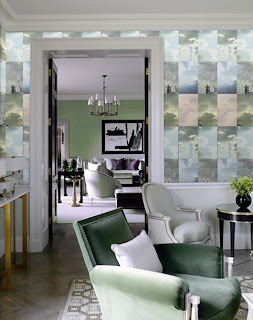A DEVELOPING DESIGNER
The debate goes on between hereditary and environmental acquisitions of talent. Are you born with the ability to see space and combine pattern and color or do you develop the talent? Case in point: our daughter. Since Emmy was adopted and we didn't use a surrogate there's no blood relationship here, but as sure as I am that Sarah Palin is a tea party conservative, Emmy shows the begins of being a gifted designer. I guess we'll never know if her sense of style was passed down from her birth parents or if it came from just hanging around with us (we've been told by several sources that we do have a knack with that sort of stuff). Emmy seems to be turning into the little designer.
Take a look at her room. The first thing that struck a cord was her understanding of concept. She wasn't willing to go out and buy just anything that caught her eye. She really stopped to ponder what it was about the feel of the room she wanted to create. Her budget was very limited and she had to work with a lot of things we already had, but she knew what she wanted was a sense of joy mixed with nostalgia.
She chose a period in time and although I didn't see her racing to the library to do any pictorial research she paid close attention to her movie references and picked up on the bohemian eclecticism of the sixties.
She then began to space plan her room doing a layout with moveable pieces representing her furniture. By this time she had a strong understanding of how she actually uses her space and how she prefers to live her life. She isn't one to sit down at desk to do her homework. Instead everything gets spread out on the bed where she lies on her stomach typing away on her computer while plugged in to her iphone listening to her music. I always give her a hard time about music but secretly I think she has a very sophisticated playbook ranging from Mumford and Sons on into Adele and Lana Del Rey.
Her room is a vision in color and pattern with a million personal touches that explain her passions and her past. Every little setting is a tableau. Her dressing table is right out of a movie set. Her bed is fit for an Indian princess. I tried to push her to go over the top but she knew when enough was enough and she wouldn't let me sway her.
When you can see your own passions showing up in the soul of your child life takes on an astonishing new meaning. It might be too early to say she's found a path in life, a direction, she-s only sixteen but to see her enjoy our profession and start to pick it up as her own is a reward a parent dreams of.
FATE
We'd been trying to figure out our role in Madison as designers and retailers. Our furniture and interior design have always been our main focus. The retail aspect of our journey here was always a way to the means. We thought the retail might provide us with some recognition and a means to acquiring a reputation and through that a client base. It had started to look like the retail part of our business had done what it could. Location is a big factor in Madison and we were too naïve to think that if you built it they would come.
Our retail clientele started dwindling and our design business started skyrocketing in the New York area. Our diligence with the store had begun to wane. Sometime last week around Friday or Saturday fate seems to have taken over when the front of our beloved little bungalow decided to part ways with the rest of the house. We're taking this as a sign and moving our design works to our home office until we find out we can't stand to be with each other 24/7. The phone remains the same, 608 251-0995. It may take us a little while to settle in but be patient. Who knows, we may end up a pop-up store somewhere where you least expect it.
THE GALLERY
Still from Ang Lee's "Taking Woodstock"
Photographer unknown






































.jpg)
















